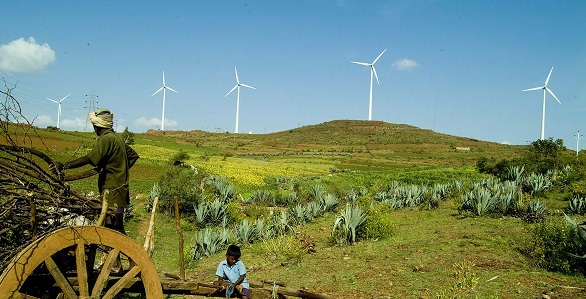India’s renewables: More to be done
March 28, 2019 | Expert Insights

Background
Since 2013, primary energy consumption in India has been the third highest in the world after China and the United States. India is the second top coal consumer after China and ranks third in oil consumption. The country imports nearly 45% of its total primary energy. Currently the world’s third-largest emitter of greenhouse gases, India has pledged to cut emissions and have clean energy make up 40% of its installed capacity by 2022, a change of 21.4%; a target of 175 gigawatts (GW) from renewable sources. Thermal power plants currently account for 75% of overall power generation and 33% of installed capacity.
With its burgeoning middle class, an expanding manufacturing sector and an increasingly urban population of 1.3 billion, India is primed to overtake China as the top driver of oil demand growth by the mid-2020s. India’s Prime Minister Narendra Modi has launched policies aimed at boosting energy access to support high levels of economic growth. The energy policy of India is largely defined by the country's expanding energy deficit; in terms of self-sufficiency, India ranks 81st in the world. The country has its increased focus on developing alternative sources of energy, particularly nuclear, solar and wind energy.
One of the main initiatives introduced by the Indian government to promote solar power is the Jawaharlal Nehru National Solar Mission, a part of the National Action Plan on Climate Change. India increased its solar power generation capacity nearly fivefold from 2,650 megawatts (MW) in 2014 to 12,288.83 MW in 2017 under this scheme.
Analysis
Beginning in June 2019, India’s Ministry of Renewable Energy will invite tenders to launch US$5 billion of transmission lines. The tenders intend to introduce the 2022 target of 175 GW from renewable energy into India’s power grid. Since December 2018, the Ministry awarded tenders for 12 GW of transmission lines, while June’s auction will offer another 16 GW of lines. The Ministry also said another 38 GW of transmission lines will be auctioned before March 2020. For these 66 GW, the secretary for Renewables, Anand Kumar, estimates an investment of 430 billion rupees.
India’s focus on solar energy comes as a result of its geographic location on the tropic of Cancer. This advantageous position provides the nation with twice as much sunshine as European countries, in a far more consistent manner. PM Modi’s government has set an ambitious target to raise solar power generation to 100 GW by 2022. Another focus for India’s renewable energy development is wind power. PM Modi’s plan is to generate 60 GW from wind by 2022. The remaining 15 GW of the targeted 175 GW is set to come from biomass and hydropower.
In 2017, PM Modi’s government altered the rules that regulated the awarding of renewable energy products with the aim of higher competition, lower prices and greater proliferation of renewable energy. The Modi government has sought to ensure that power from these sources comes at a competitive price that remains affordable for its consumers. Mr. Kumar said that tariffs had dropped significantly from 6.17 rupees per unit to as low as 2.44 rupees per unit. Mr. Kumar also added that India was currently ahead of its initial target to award 135 GW of renewable energy projects by March 2019. Projects amounting to 103 GW have already been installed or being installed, while 37 GW are in various stages of bidding. In order to account for India’s growth, additional capacity is set to exclusively come from renewable energy, with none of India’s private power producers planning to invest in new coal-fired power plants.
Counterpoint
Some analysts have voiced scepticism about India’s ambitious targets, based on a variety of policy-related issues. These include the cancellations of auctions of tenders, land-rights and tariffs. India has cancelled tenders of at least 5 GW of projects over pricing issues. Developers of renewable energy have voiced concerns about difficulties with leasing land and exorbitant tariffs on imports.
Assessment
Our assessment is that India needs to reduce its carbon emissions in order to dampen the effects of climate change. We believe that while PM Modi’s plan to secure 175 GW from renewable sources by 2022 is ambitious, it is imperative that the nation meets the target. We believe that in order to secure this target the government must ease access to technology that facilitates the development of renewable energy, while further simplifying bureaucratic hurdles that remain in place.
Image courtesy: Wikimedia Commons, Creative Commons








Comments